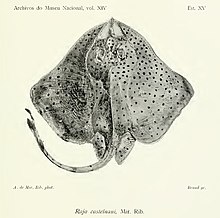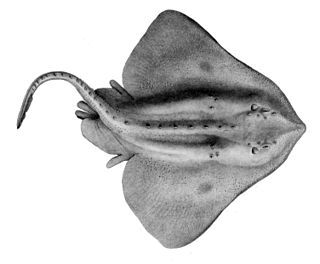
Skates are cartilaginous fish belonging to the family Rajidae in the superorder Batoidea of rays. More than 150 species have been described, in 17 genera. Softnose skates and pygmy skates were previously treated as subfamilies of Rajidae, but are now considered as distinct families. Alternatively, the name "skate" is used to refer to the entire order of Rajiformes.

Rajiformes is one of the four orders in the superorder Batoidea, flattened cartilaginous fishes related to sharks. Rajiforms are distinguished by the presence of greatly enlarged pectoral fins, which reach as far forward as the sides of the head, with a generally flattened body. The undulatory pectoral fin motion diagnostic to this taxon is known as rajiform locomotion. The eyes and spiracles are located on the upper surface of the head and the gill slits are on the underside of the body. Most species give birth to live young, although some lay eggs enclosed in a horny capsule.

The Portuguese dogfish or Portuguese shark, is a species of sleeper shark of the family Somniosidae. This globally distributed species has been reported down to a depth of 3,675 m (12,057 ft), making it the deepest-living shark known. It inhabits lower continental slopes and abyssal plains, usually staying near the bottom. Stocky and dark brown in color, the Portuguese dogfish can be distinguished from similar-looking species by the small spines in front of its dorsal fins. Its dermal denticles are also unusual, resembling the scales of a bony fish. This species typically reaches 0.9–1 m (3.0–3.3 ft) in length; sharks in the Mediterranean Sea are much smaller and have distinct depth and food preferences.

The blackmouth catshark is a species of catshark, and part of the family Scyliorhinidae, common in the northeastern Atlantic Ocean from Iceland to Senegal, including the Mediterranean Sea. It is typically found over the continental slope at depths of 150–1,400 m (490–4,590 ft), on or near muddy bottoms. The youngest sharks generally inhabit shallower water than the older juveniles and adults. This slim-bodied species is characterized by the black interior of its mouth, a marbled pattern of pale-edged brownish saddles or blotches along its back and tail, and a prominent saw-toothed crest of enlarged dermal denticles along the upper edge of its caudal fin. It reaches lengths of 50–79 cm (20–31 in), with sharks in the Atlantic growing larger than those in the Mediterranean.

The barndoor skate is a species of marine cartilaginous fish in the skate family Rajidae of the order Rajiformes. It is native to the northwestern Atlantic Ocean, and is found from the Grand Banks of Newfoundland and the southern side of the Gulf of St. Lawrence south to North Carolina. The fish is one of the largest skates found in the North Atlantic Ocean, reaching lengths up to 1.5 m (5 ft). It is carnivorous, feeding on invertebrates and other fish found near the sea floor.
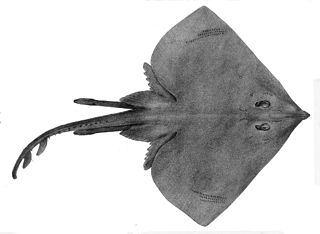
Atlantoraja is a genus of skates in the family Arhynchobatidae. They are found from near sea level to depths of 300 metres (980 ft) in the Atlantic Ocean off Argentina, Brazil and Uruguay. These fish are all considered threatened due to the intense fishing pressure within their range.
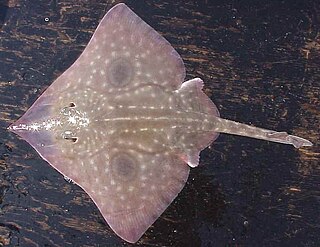
The big skate is the largest species of skate in the waters off North America. They are found along the Pacific Coast from Alaska to Baja California, typically from the intertidal zone to a depth of 120 m (390 ft), and feed on benthic invertebrates and small fishes. They are unusual among skates in that their egg cases may contain up to seven eggs each. This species is one of the most commercially important skates off California and is sold for food.

The bottlenose skate, spearnose skate, or white skate is a species of skate in the family Rajidae. It is a benthic fish native to the coastal eastern Atlantic Ocean. Due to overfishing, it has been depleted or extirpated in many parts of its former range in the northeastern Atlantic and the Mediterranean Sea, and is now endangered.

Arhynchobatidae is a family of skates whose members are commonly known as the softnose skates. It belongs to the order Rajiformes in the superorder Batoidea of rays. At least 104 species have been described, in 13 genera. Softnose skates have at times been placed in the same family as hardnose skates, but most recent authors recognize them as a distinct family. Members of the Arhynchobatidae can be distinguished from hardnose skates in having a soft and flexible snout, as well as a more or less reduced rostrum.

The shagreen ray, also known as shagreen skate or fuller's ray, is a species of skate in the family Rajidae. This ray is found in the eastern Atlantic Ocean, from Murmansk, Russia through Norway, southern Iceland, the Faroe Islands, the Celtic Sea, the northern North Sea and Skagerrak, to western Morocco and the Madeira archipelago, but not in the shallow waters off England and Wales. It is also recorded sporadically in the Mediterranean Sea.

The little skate is a species of skate in the family Rajidae, found from Nova Scotia to North Carolina on sand or gravel habitats. They are one of the dominant members of the demersal fish community in the northwestern Atlantic. This species is of minimal commercial importance and is mostly used as bait for lobster traps, though its wings are also marketed for food. It is also important as a model organism for biological and medical research.

Batoidea is a superorder of cartilaginous fishes, commonly known as rays. They and their close relatives, the sharks, compose the subclass Elasmobranchii. Rays are the largest group of cartilaginous fishes, with well over 600 species in 26 families. Rays are distinguished by their flattened bodies, enlarged pectoral fins that are fused to the head, and gill slits that are placed on their ventral surfaces.

The mottled skate is a species of skate in the family Rajidae. An inhabitant of shallow coastal waters, it is found in the northwestern Pacific Ocean off Korea, Japan, and China. This species grows to 1.12 m (3.7 ft) long and has a diamond-shaped pectoral fin disc with a long snout. It is characterized by a covering of prickles above and below its snout, but not elsewhere on its body, and a dark ring in the middle of each "wing".

The clearnose skate is a species of cartilaginous fish in the family Rajidae. R. eglanteria is also known by other common names such as the brier skate and summer skate. Clearnose skates are easily identified by the translucent patches on either side of their snouts and their mottled dorsal surface. They are found along the Atlantic and Gulf coasts of the United States in shallow waters of the continental shelf.

The graytail skate, or gray tail skate, is a large species of skate in the family Arhynchobatidae, native to the south-western Atlantic Ocean and south-eastern Pacific Ocean. It is listed as endangered by the IUCN. It was caught as part of a commercial fishery around the Falkland Islands and is a bycatch in several other fisheries.
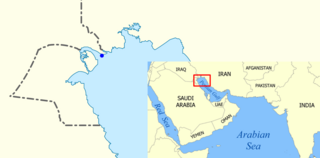
The pita skate is a medium-sized skate in the family Rajidae. The holotype and only known specimen was found in the northern Persian Gulf, in Iraqi waters. It was collected at a depth of less than 15 m (49 ft).
The Norwegian skate, or black skate, is a species of skate found at depths of 200 m (660 ft) to over 1,600 m (5,200 ft) in the East Atlantic region. Initially its range was believed to be restricted to the Norwegian Sea and North Sea to the Bay of Biscay. It is occasionally encountered off the western coast of Ireland, and historically has been found near Rockall and in the Norwegian Deep, though recent surveys have not identified the species there. The species has frequently been confused with other skates, and since the late 1980s it has been confirmed to occur more widely, ranging from Iceland to Morocco, as well as off South Africa and in the Mediterranean Sea.

The rough ray is a Mediterranean ray species of the Rajidae family described by Delaroche in 1809.

The blonde ray or blonde skate is a species of ray fish in the family Rajidae.
Bigelow's ray, also called the chocolate skate or Bigelow's skate, is a species of skate in the family Rajidae. It is named in honour of the oceanographer Henry Bryant Bigelow.
